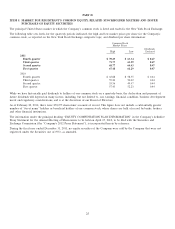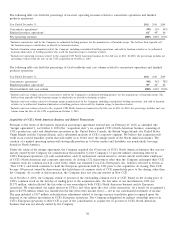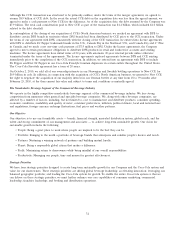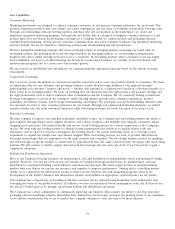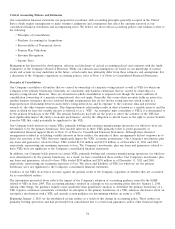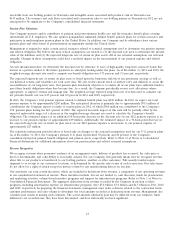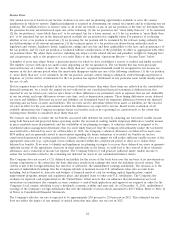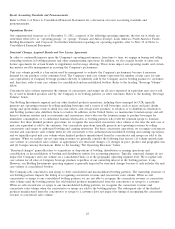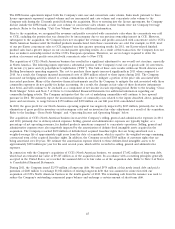Coca Cola 2011 Annual Report Download - page 37
Download and view the complete annual report
Please find page 37 of the 2011 Coca Cola annual report below. You can navigate through the pages in the report by either clicking on the pages listed below, or by using the keyword search tool below to find specific information within the annual report.given by the Company. These financial arrangements, although not significant to our consolidated financial statements, resulted in
a disproportionate relationship between our voting interests in these entities and our exposure to the economic risks and potential
rewards of the entities. As a result, we determined that we held a majority of the variable interests in these entities and, therefore,
were deemed to be the primary beneficiary in accordance with accounting principles generally accepted in the United States as of
December 31, 2009. Although these financial arrangements resulted in us holding a majority of the variable interests in these
VIEs, the majority of these arrangements did not empower us to direct the activities of the VIEs that most significantly impact
the VIEs’ economic performance. Consequently, subsequent to the change in accounting policy, the Company deconsolidated the
majority of these VIEs.
The entities that have been deconsolidated accounted for less than 1 percent of net income attributable to shareowners of The
Coca-Cola Company in 2009. On January 1, 2010, the Company began to account for these entities under the equity method of
accounting. Although the deconsolidation of these entities impacted individual line items in our consolidated financial statements,
the impact on net income attributable to shareowners of The Coca-Cola Company in future periods will be nominal. The equity
method of accounting is intended to be a single line consolidation and, therefore, generally should result in the same net income
attributable to the investor as would be the case if the investee had been consolidated. The main impact on our consolidated
financial statements in 2010 was that, instead of these entities’ results of operations and balance sheets affecting our consolidated
line items, our proportionate share of net income or loss from these entities was reported in equity income (loss) — net in our
consolidated statements of income, and our investment in these entities was reported as equity method investments in our
consolidated balance sheets. Refer to the heading ‘‘Operations Review — Structural Changes, Acquired Brands and New License
Agreements’’ below for additional information.
Purchase Accounting for Acquisitions
The Company adopted new guidance issued by the FASB on January 1, 2009, which changed the application of the acquisition
method of accounting in a business combination and also modified the way assets acquired and liabilities assumed are recognized
on a prospective basis. In general, the acquisition method of accounting requires companies to record assets acquired and
liabilities assumed at their respective fair market values at the date of acquisition. We estimate fair value using the exit price
approach, which is defined as the price that would be received if we sold an asset or paid to transfer a liability in an orderly
market. The value of an exit price is determined from the viewpoint of all market participants as a whole and may result in the
Company valuing assets at a fair value that is not reflective of our intended use of the assets. Any amount of the purchase price
paid that is in excess of the estimated fair values of net assets acquired is recorded in the line item goodwill in our consolidated
balance sheets. Management’s judgment is used to determine the estimated fair values assigned to assets acquired and liabilities
assumed, as well as asset lives for property, plant and equipment and amortization periods for intangible assets, and can materially
affect the Company’s results of operations.
Transaction costs, as well as costs to reorganize acquired companies, are expensed as incurred in the Company’s consolidated
statements of income.
On October 2, 2010, the Company acquired CCE’s North American business and recorded total assets of $22.2 billion as of the
acquisition date. The assets we acquired included a material amount of intangible assets that were subject to the significant
estimates described above. During our purchase accounting measurement period, which concluded during the third quarter of
2011, the Company made adjustments to certain amounts that resulted in a final balance of $22.0 billion of total assets being
recorded in our consolidated balance sheets related to the CCE acquisition. Refer to the heading ‘‘Recoverability of Noncurrent
Assets’’ below and Note 2 of Notes to Consolidated Financial Statements for further information related to this acquisition.
Recoverability of Noncurrent Assets
We perform recoverability and impairment tests of noncurrent assets in accordance with accounting principles generally accepted
in the United States. For certain assets, recoverability and/or impairment tests are required only when conditions exist that
indicate the carrying value may not be recoverable. For other assets, impairment tests are required at least annually, or more
frequently, if events or circumstances indicate that an asset may be impaired.
Our equity method investees also perform such recoverability and/or impairment tests. If an impairment charge was recorded by
one of our equity method investees, the Company would record its proportionate share of such charge as a reduction of equity
income (loss) — net in our consolidated statements of income. However, the actual amount we record with respect to our
proportionate share of such charges may be impacted by items such as basis differences, deferred taxes and deferred gains.
Management’s assessments of the recoverability and impairment tests of noncurrent assets involve critical accounting estimates.
These estimates require significant management judgment, include inherent uncertainties and are often interdependent;
therefore, they do not change in isolation. Factors that management must estimate include, among others, the economic life of
the asset, sales volume, pricing, cost of raw materials, inflation, cost of capital, marketing spending, foreign currency exchange
35


